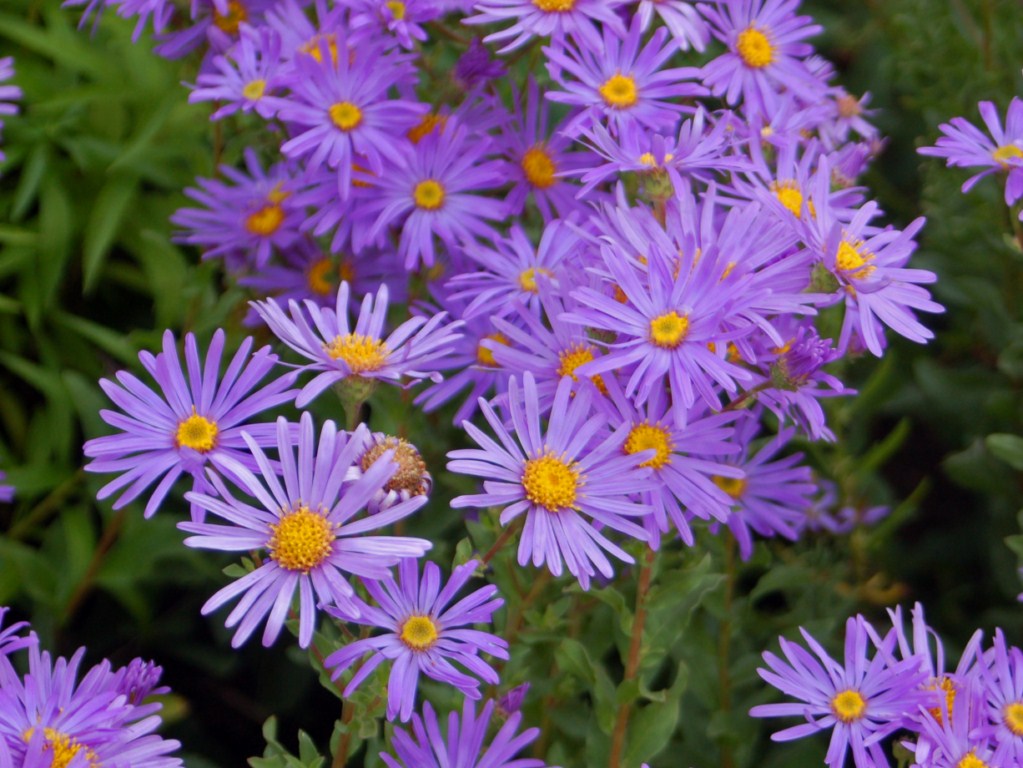Few flowers capture the essence of autumn quite like the aster. With its star-shaped blossoms and cheerful hues, the aster is a symbol of patience, elegance, and the soft beauty of the fading seasons. From late summer into fall, asters bring brilliant bursts of color to gardens, borders, and wild meadows alike, attracting bees, butterflies, and admiration wherever they bloom.
Whether planted en masse in sweeping drifts or nestled into container gardens, asters offer both visual charm and ecological value. Hardy, reliable, and radiant—they are the quiet stars of the changing year.

Portrait of the Aster
The name Aster comes from the Greek word for “star,” and rightfully so. These daisy-like flowers shine with a central yellow eye and radiating petals in shades of purple, pink, white, and blue. There are over 170 species, primarily native to North America, with the most commonly cultivated varieties including Aster novae-angliae (New England Aster) and Aster novi-belgii (New York Aster), both members of the Symphyotrichum genus due to modern botanical classification.
Asters are perennials, meaning they return each year, and are cherished for their late-season blooms when many other flowers have faded.
Foliage and Form
Asters grow in upright clumps, often reaching heights between 30 cm and 1.5 meters (1 to 5 feet), depending on the species. Their foliage is typically narrow and lance-shaped, a deep green that provides a neat backdrop to their abundant flowers.
- Form: Bushy, branching stems covered in blossoms from top to base during peak bloom.
- Excellent for borders, wildflower gardens, and pollinator plots.
Blooms and Fragrance
The true charm of the aster lies in its daisy-like flowers, which appear in abundance late in the growing season. Most asters bloom from late August through October, filling gardens with rich color.
- Colors: Purples, blues, pinks, white, and even soft reds.
- Fragrance: Most asters have a mild, earthy fragrance. While not highly perfumed, they are beloved by pollinators.
The Right Time to Plant and Care for Asters
Asters are best planted in spring or early fall, allowing roots to establish before extreme temperatures arrive. Pruning is essential during the growing season to encourage bushier growth and more prolific flowering.
| Month | Planting | Flowering | Pruning |
|---|---|---|---|
| January | ❌ | ❌ | ❌ |
| February | ❌ | ❌ | ❌ |
| March | ✅ (early spring) | ❌ | ✅ (cut back old growth) |
| April | ✅ | ❌ | ✅ (pinch tips) |
| May | ✅ | ❌ | ✅ (encourage bushiness) |
| June | ✅ | ❌ | ✅ (last pinch before buds form) |
| July | ❌ | ❌ | ✅ (light tidy only) |
| August | ❌ | ✅ | ❌ |
| September | ❌ | ✅ | ❌ |
| October | ❌ | ✅ | ❌ |
| November | ❌ | ✅ (late bloomers) | ✅ (cut back after frost) |
| December | ❌ | ❌ | ❌ |
✅ = Recommended ❌ = Not advised
Ideal Watering, Sunlight, and Environment for Asters
Watering
- Asters prefer moderate, consistent watering.
- Soil should be moist but well-drained—avoid soggy roots.
- During dry spells, especially when in bloom, water deeply once a week.
Sunlight
- Asters need full sun (6+ hours of sunlight daily) for the best blooms.
- They will tolerate partial sun but may become leggy and flower less.
Indoor vs Outdoor
- Asters are outdoor perennials, well-suited for garden beds, borders, and meadows.
- Not commonly grown indoors, though small varieties may survive in large containers on sunny balconies or patios.
Temperature
- Hardy in USDA Zones 3–8, asters can tolerate frost and even thrive after early fall chills.
- Require a cold winter dormancy to bloom well the following year.
Ideal Soil Conditions for Growing Asters
| Soil Feature | Optimal Condition | Why It Matters |
|---|---|---|
| Soil Type | Loamy, well-draining | Prevents waterlogging and root rot |
| Texture | Loose and crumbly | Encourages root spread and aeration |
| Drainage | Good drainage essential | Protects against fungal diseases |
| Moisture | Moderate – never soggy | Maintains healthy growth and steady flowering |
| Soil pH | Slightly acidic to neutral (6.0–7.0) | Supports nutrient uptake and strong blooms |
| Amendments | Compost or organic mulch | Improves texture and retains balanced moisture |
Common Problems & Solutions
| Issue 🐾 | Symptoms 🔍 | Solutions 🛠️ |
|---|---|---|
| Powdery Mildew 🦠 | White powder on leaves | Improve air flow, avoid overhead watering, use fungicide if needed |
| Aphids 🐜 | Sticky residue, curling leaves | Spray with water or neem oil, encourage ladybugs |
| Rust Spots 🍂 | Orange or brown spots on undersides of leaves | Remove affected foliage, apply organic fungicide |
| Leggy Growth 🌿 | Tall, weak stems, fewer flowers | Pinch or cut back in early season to promote bushiness |
| Yellowing Leaves 🍃 | Overwatering or poor drainage | Adjust watering, check for compacted soil |
With their vibrant blooms and cool-weather endurance, asters are a must-have for anyone looking to extend their garden’s color well into autumn. They blend beautifully with grasses, goldenrods, and late-blooming perennials—providing texture, color, and charm when most flowers are fading. A reliable favorite for gardeners and pollinators alike.